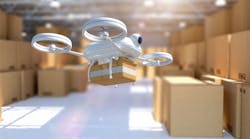It’s been nearly six years since the FAA approved the first commercial UAS (unmanned aircraft system) flight over land, with UAS manufacturer AeroVironment holding the distinction of being the first to take advantage of this new rule by using one of its Puma AE drones for aerial surveys in Alaska.
“These surveys on Alaska’s North Slope are another important step toward broader commercial use of unmanned aircraft,” said Transportation Secretary Anthony Foxx in a press release at the time. “The technology is quickly changing, and the opportunities are growing.”
Since then, commercial drone development and activity have both gained momentum. Shell Oil uses safety and compliance inspection drones; the BBC has a drone journalism team; Walmart applied for a patented drone system to carry items around the store; and the DHL “Parcelcopter” is being tested for parcel deliveries, Nevada Institute for Autonomous Systems (NIAS) reports.
Recent Developments
More recently, Zipline launched the largest drone delivery network in the world; Flytrex created the first cloud-connected drone designed for deliveries; and the Matternet One—the first smart drone made exclusively for transportation—was introduced to the world, according to UAV Coach.
These and other advancements on the transportation and logistics front are helping to push the commercial drone market into new territory. According to the FAA, the market itself could see explosive growth over the next three years. “The market for commercial drones is growing faster than anticipated, and could triple between now and 2023, while the market for non-commercial drones appears to be slowing,” The Verge reports.
For the commercial drone category, the FAA says “the pace of monthly registration (almost 15,000), is nearly three times higher than the pace at which non-model aircraft owners registered their craft during the same time last year.” The administration says that as of the end of 2018, more than 27,000 non-model drones had been registered.
In “Mastering the Skies: The Dawn of Commercial Drones,” Jabil’s Chris Huskamp writes that the commercial drone sector is “eager to jump on the plethora of opportunities” that UAVs provide. Valued at $5.8 billion in 2018, the commercial drone market is expected to reach $129 billion by 2025—representing a 56.5% compound annual growth rate (CAGR), Grand View Research reports.
A Long Time Coming
Pointing out that the first pilotless winged aircraft—the Ruston Proctor Aerial Target—was built in 1916, Huskamp says that while drones were originally designed for defense applications, the commercial sector will “supercharge” this technology in the upcoming years. He adds that current drone technology has already surpassed manned aircraft in endurance, range, safety and cost-efficiency.
“As the demand for commercial drones rises, this discrepancy in capabilities is only expected to increase,” Huskamp predicts. “Unmanned flight will add greater stealth, advanced sensing, payload diversity, range, long flight endurance, autonomy and communications capabilities.”
Because they operate on electricity, commercial drones require no gas and emit less carbon, thus providing an eco-friendlier alternative to airplanes and delivery trucks. “They also contribute to time and cost reduction in most applications,” Huskamp writes, “and can save man-hours, costs and perform hazardous or unreachable tasks.”
Ready for Drone Deliveries?
The question is, when will companies start to see their B2B deliveries arrive by drone versus truck, van or rail? The day may not be too far off. In February, the FAA proposed to certify specific drones for package deliveries, DroneDJ reports.
This is the first time the FAA has presented a formal policy plan to make sure that drones used to make package deliveries will meet certain safety and airworthiness requirements, it adds: “The move is seen as a crucial step in allowing routine package deliveries by drones in the not too distant future.”
“Companies are mastering roads, but there is one avenue of delivery that businesses are still seeking to master: the sky,” Huskamp writes. “Commercial drones are taking off…literally and metaphorically.”










